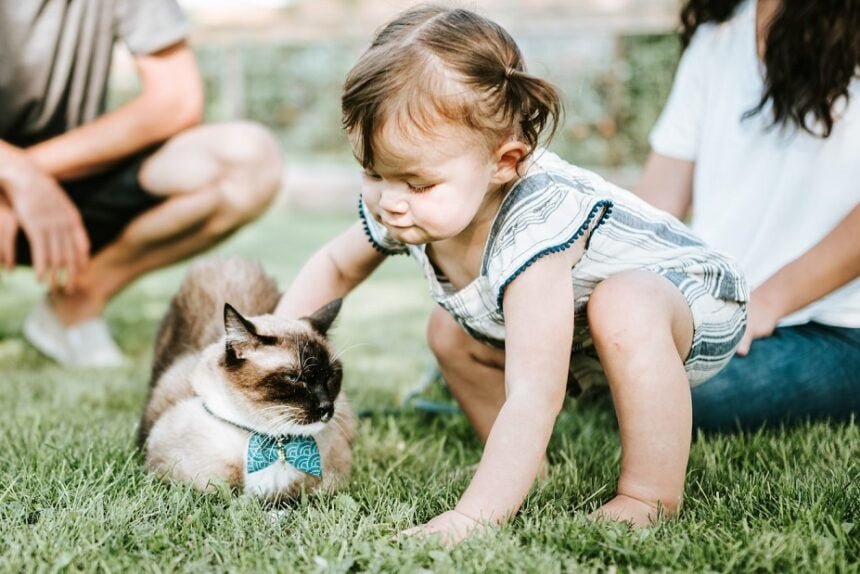Interacting with cats can have numerous benefits for children. It helps them develop empathy, responsibility, and nurturing skills. The companionship of a cat can also provide emotional support and reduce stress in children. Additionally, studies have shown that children who grow up with cats are less likely to develop allergies and asthma. This introduction sets the stage for the rest of the article, highlighting the positive impact of cats on children’s well-being.
Understanding the Dynamics: Children and Cats
This section explores the unique dynamics between children and cats. It delves into the differences in behavior, communication, and socialization patterns of both. Understanding these dynamics is crucial for facilitating positive interactions. Children need to learn that cats have their own boundaries and preferences and should be treated with respect. Likewise, cats need to adjust to the energy and curiosity of children. Providing insights into these dynamics will help parents and caregivers create a harmonious environment for both children and cats.
Creating a Safe Environment for Kids and Cats
This section focuses on creating a safe space for children and cats to interact. It covers practical aspects such as childproofing the house, ensuring a designated safe area for the cat, and minimizing potential hazards. It also emphasizes the importance of providing retreat spaces for cats where they can feel secure and have a break from children’s interactions. The section provides tips on maintaining a clean environment and addressing hygiene concerns.
Teaching Kids How to Approach Cats
Approaching cats correctly is crucial for ensuring positive interactions. This section offers guidance on teaching children the appropriate way to approach a cat, such as using slow and gentle movements and avoiding sudden noises or gestures. It emphasizes the importance of respecting a cat’s personal space and allowing the cat to initiate contact. By educating children on respectful behavior towards cats, this section promotes a safer and more enjoyable experience for both parties.
Building Trust and Respect between Kids and Cats
Building trust and respect is essential for fostering a strong bond between children and cats. This section provides strategies for gradually introducing children and cats, allowing them to get acquainted at their own pace. It emphasizes the significance of positive reinforcement and rewards for both the child and the cat. Teaching children to be patient and understanding with cats will help them develop empathy and deepen their bond.
Supervising Interactions: Dos and Don’ts
Supervision is vital when children and cats interact, especially with younger children. This section highlights the importance of adult supervision to ensure the safety of both the child and the cat. It offers practical tips on how to effectively monitor their interactions, such as intervening when necessary, redirecting inappropriate behavior, and setting boundaries. It also emphasizes the need to teach children not to disturb cats while they eat, sleep, or use their litter boxes.
Promoting Gentle Play and Boundaries
Children often engage in playful activities with cats, and this section provides guidance on promoting gentle play. It encourages the use of appropriate toys and games that stimulate the cat’s natural instincts without causing harm. It also emphasizes the importance of setting boundaries and teaching children not to engage in rough play or pull on a cat’s tail or ears. By promoting gentle play, children can develop a deeper understanding of a cat’s needs and preferences.
Teaching Kids to Read Cat Body Language
Understanding cat body language is crucial for children to recognize and respond appropriately to a cat’s signals. This section provides an overview of common cat body language cues, such as tail movements, ear positions, and vocalizations. It teaches children to identify signs of fear, aggression, or discomfort, and encourages them to adjust their behavior accordingly. By teaching kids to read cat body language, they can develop empathy and learn to respect a cat’s boundaries.
Involving Kids in Basic Cat Care
Caring for a cat is a shared responsibility, and involving children in basic cat care tasks can foster a sense of responsibility and empathy. This section offers age-appropriate tasks that children can engage in, such as feeding the cat, cleaning the litter box (under adult supervision), grooming, and providing fresh water. It emphasizes the importance of supervision and guidance to ensure the well-being of both the child and the cat.
Nurturing Empathy and Responsibility through Cat Interactions
This section explores how interactions with cats can cultivate empathy and responsibility in children. It highlights the emotional connection that can develop between a child and a cat, and how caring for a pet can teach valuable life lessons. It suggests discussing the importance of meeting a cat’s needs and the impact of our actions on their well-being. By nurturing empathy and responsibility, children can develop into compassionate and caring individuals.
Dealing with Allergies and Hygiene Concerns
Allergies and hygiene concerns can sometimes be a challenge when kids interact with cats. This section provides information on how to address these issues. It discusses common allergens found in cat dander and offers practical tips on reducing exposure, such as frequent handwashing, keeping the living space clean, and maintaining proper ventilation. It also advises consulting with a healthcare professional if a child exhibits allergic reactions. By addressing allergies and maintaining good hygiene practices, children can safely enjoy their interactions with cats.
Addressing Fear and Anxiety in Children around Cats
Some children may experience fear or anxiety when interacting with cats. This section provides strategies for helping children overcome their fears and gradually build confidence. It emphasizes the importance of gentle exposure, allowing the child to observe cats from a distance and slowly introducing closer interactions. It suggests engaging the child in positive experiences with cats, such as supervised play and feeding. By addressing fear and anxiety, children can develop a positive and comfortable relationship with cats.
Introducing Cats to Babies and Toddlers: Tips for a Smooth Transition
Introducing a cat to a new baby or toddler requires careful consideration and preparation. This section offers guidance on making the transition smooth and stress-free for both the cat and the child. It emphasizes the importance of gradually acclimating the cat to the presence of the child, creating safe spaces, and teaching the child gentle interactions. It also provides tips on supervising their interactions and promoting a positive bond. By following these guidelines, families can create a harmonious environment when introducing cats to babies and toddlers.
Understanding the Benefits of Therapy Cats for Children
Therapy cats can have a significant impact on children’s well-being, particularly those with special needs or facing challenging circumstances. This section explores the benefits of therapy cats, such as providing emotional support, reducing anxiety, and aiding in social and cognitive development. It discusses the role of trained therapy cats in various settings, such as hospitals, schools, and therapy centers. Understanding the benefits of therapy cats can help parents and caregivers explore these programs as a potential resource for their children’s well-being.
Conclusion: Fostering Lifelong Bonds between Kids and Cats
In the conclusion, the article emphasizes the importance of fostering lifelong bonds between children and cats. It highlights the positive impact that these interactions can have on children’s emotional, social, and cognitive development. It encourages parents and caregivers to provide a safe and nurturing environment, teach children empathy and responsibility, and create opportunities for positive interactions with cats. By fostering lifelong bonds between kids and cats, we can create enriching experiences and lasting companionship for both.







